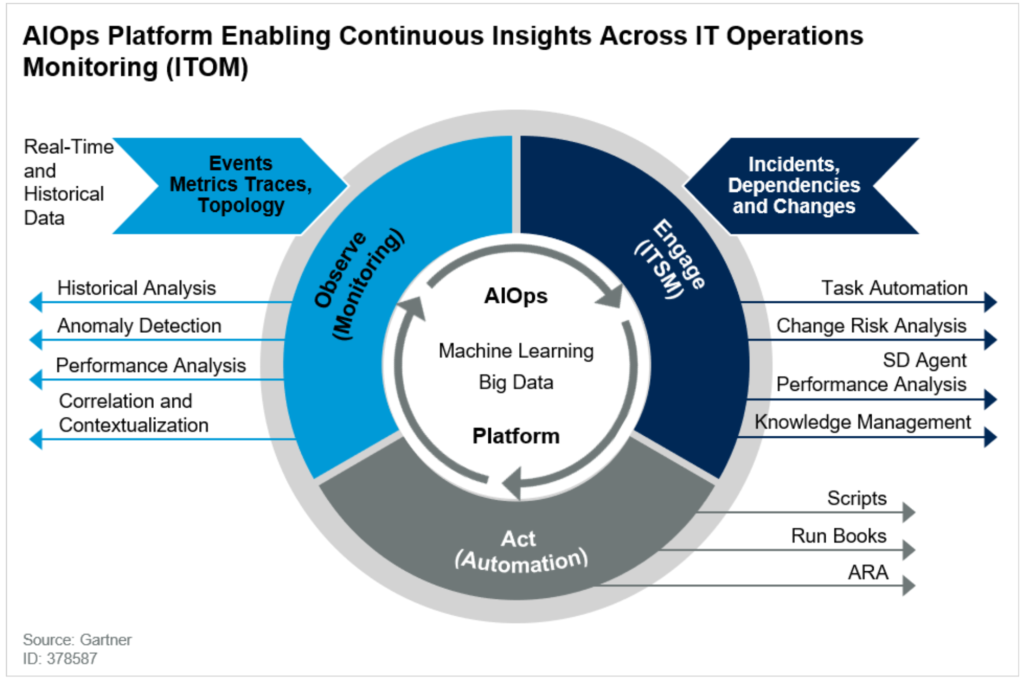The modern world is gearing up for the Fourth Industrial Revolution, with smart devices in its hands and rocket-fast data processing capabilities empowering business operations. Amidst the trends, automation and digitization emerge as the two major agendas that exist on the majority of business portfolios.

More than 80% of business organizations are going to increase their spending on automation. And recent market studies predict that the digital process automation market will hit the 16.12 bn USD mark by 2026, demonstrating a CAGR of 12.98 %.
As the automation needs in modern workplaces are reaching new heights and IT operations are looking for smarter, more intuitive, and reliable ways to automate and digitize routine tasks, people are turning to AI.
And promising to fulfill such a diverse set of process automation requirements in IT is AIOps.
Coined by Gartner in 2016, AIOps stands for Artificial Intelligence for IT Operations and combines ML and big data for process automation in IT operations, such as causality determination, anomaly detection, event correlation, etc.
In upcoming sections, you can learn about AIOps in detail, why and how you should consider them for your business, and major ways AIOps will change the face of IT operations in 2022.
How are businesses deploying AI to support customer loyalty? Click here for insights!
What is AIOps?
AIOps is an industry category that uses AI and ML analytics for automating, streamlining, and enhancing IT operations analytics. AIOps provides a real-time understanding of any type of underlying issues in the IT organizations and real-time insights into various processes. It also offers predictive business intelligence in various forms and across a wide range of business processes because of its smart analytics capabilities.
Increasing complexities of IT systems, organizational data growing at an extreme pace, and frequent industry disruptions, such as remote work, new trends in technology, rapidly changing markets, etc., have fuelled the demand for AIOps.
Why AIOps: Exploring the Need for Futuristic IT Ops Tech
AIOps software not only empowers the organizations to manage the heaps of data they generate, but it will also help in harnessing the true power of this data via analytics.
You can identify any hidden patterns for growth, cost efficiency, redundancy, productivity, etc., and gather actionable insights from them. Apart from the data insights derived from historical organizational data, you can also use predictive analytics to have futuristic insights into various segments that are reliable and data-driven.
But then again, mere insights cannot solve the massive automation and digital transformation needs; right?
Hence, AIOps also caters to the team collaboration needs and provides inferences drawn from the data insights, such as:
- Recurring system problems that are affecting productivity
- The root causes of various organizational challenges
- Specific processes that can be automated without much ado
Finally, AIOps aids in automating the response and remediation in various instances, to facilitate precise and quick process automation across your business model.
The following image shows some of the core functionalities of AIOps, as discussed above:
Now that we have had an overview, let us move on to discuss some key use cases of AIOps.
What’s going on in the world of retail automation? Get an overview here!
AIOps: Key Use Cases
While there can be n number of business use cases for AIOps, we are discussing the top 5 core use cases that target the key problem areas when it comes to operations, processes and automation.
1. Big Data Management
While big data is a powerful technology to manage, process and make sense of the tons of organizational data that is generated, managing the volume, variety, velocity and efficiency of big data usage is also a challenge. As more and more firms are using big data analytics, getting the best value out of these efforts is also a must.
Hence, proper management of big data is one of the most crucial use cases of AIOps.
2. Performance Analysis
Organizational performance analysis is an extremely daunting task as it requires micro-monitoring apart from micro-management. Now, you might think that using time tracking and employee tracking software can do the job to a greater extent. However, when it comes to getting granular insights about the results, driven by individual employee performance, this software crumbles down.
Having impeccably smart capabilities stemming from AI, ML, NLP, etc., AIOps is your eye to the nitty-gritty details related to performance analysis in any department and for any number of employees.
It can rapidly gather and process the vast amount of event logs and data to drill down to the root cause of factors that are obstructing the overall productivity of your organization.
3. IT Service Management
IT Service Management or ITSM refers to designing, building, supporting, delivering, and managing IT services in an organization. All the processes, policies, and procedures that facilitate the delivery of IT services to the end-users in an organization also come under ITSM.
AIOps uses artificial intelligence to discover any underlying issues in ITSM and helps fix them quickly, thereby improving the efficiency across all the departments. AIOPs also find usage in data monitoring and infrastructure process management. It can make more accurate predictions for planning capacity, allowing you to maximize your resource and inventory space utilization. You can also identify, predict, analyze and prevent any underlying IT service issues.
4. Event Correlation and Analysis
When it comes to event storms, most of the traditional analytics software fails because they lack the ability to provide insights into these storms.
For example, suppose your event correlation report suggests a delay in project delivery for 2 of your crucial clients, as a designer has given a notice period and you still have not hired a new designer. Now, even if you “know” what is going to happen, there is no suggestion or insight to rely upon.
AIOps, on the other hand, can help you make the best decision for remedying the situation by grouping similar events. So, you can either get an insight about a solution that came to your rescue in such a situation sometime earlier, say a few months, or you can get to know which one is the best option – outsourcing, a quick hire, or assigning the work to other designers in the company.
So, AIOps reduces the burden of the IT teams when it comes to managing organizational events and offers reliable insights to help you take the best action.
5. Automation
AIOps facilitates automation across the entire business model – cloud, storage, virtual components, remote teams, data containers, OS, networks, etc.
With its impeccably smart, powerful, and advanced data monitoring, data processing, and management capabilities, you can easily find the tasks that you can automate and put under the reliable and robust management of AIOps.
So, this brings us to a question that is one of the burning topics amid the rapid technological development and rampant disruptions – Is AIOps a doom for humans? Will they be no longer relevant?
Well, the answer is no!
While smart automation and streamlining of operations and processes will obviously limit the number of people required for mundane or data entry jobs, humans will still be critical for success, innovation, development, and leveraging the tech for the best business purposes. This is because no matter how smart tech becomes, the emotional quotient and the innate ability to think and perceive will always keep human talent more worthwhile.
Hence, while AIOps is the future of IT operations, it requires humans to produce the desired results.
Major Ways AIOps Will Change the Face of IT Operations in 2022
1. Cloud-Native Architecture
More and more business organizations, including SMEs, are moving towards the cloud-native architecture to develop and deliver apps at a quick pace. However, ensuring the reliability of security, governance, better and quicker incident resolution, and server reliability still remains a concern.
Further, the cloud-native environments have many pain points, such as:
- A huge number of alerts for every process
- Complex deployments
- Confusing and complex root cause analysis
- Manual remediation
- Lack of visibility
AIOps brings the power of AI and ML to help you overcome these challenges as well as offers extremely data-driven and actionable insights to resolve the pain points of lack of visibility.
You can also automate the incident reporting and remediation to some extent, as applicable to your business model. Another plus point is the ability of AIOps to drill deep into the data containers and siloed data units to find the root causes of various issues, such as continuous deployment failures or crashes, etc.
So, the cloud-native architecture is going to get revolutionized with AI-derived insights, AI-enabled governance, and AI-powered automation, as shown in the following image:
2. Digital Reinvention
With its highly advanced and smart capabilities, AIOps is going to play a crucial role in digital transformation, disruption and digital operations management across various industries and businesses.
AIOps offers flawless and accurate insights into all layers of the IT processes and uses machine learning to separate problems requirring urgent solutions from false alarms that can distract the team. This is of extreme importance in business organziations with extremely complex environment, such as global supply chain management and operations optimization.
AI and ML will also be of paramount importance in performance data analysis as well as discovering hidden patterns in the data. Hence, the teams can dig deeper into various data containers and can get actionable insights that are highly reliable and are not vulnerable to data breaks introduced by siloed data.
This will, in turn, facilitate the “no-code” data processing and data intelligence that will benefit people and businesses alike.
Finally, AIOps can find out the processes that are redundant, and that can be automated to improve workplace productivity, efficiency and overall employee satisfaction.
3. Augment Decision-Making in DevOps
DevOps finds its essence in rapid application delivery and this makes it vulnerable to security issues that are not uncovered during the testing done only after the application is fully developed.
However, testing each module will not only reduce the pace of development but also make the entire process of development and testing increasingly complex.
Hence, the AIOps!
AIOps has this superpower of offering continuous data streams for various processes, such as anomaly detection, causality prediction, pattern recognition, etc. It can also manage the event correlation and root cause analysis effortlessly to ensure better and more reliable testing.
Hence, AIOps is all set to change the way we currently know and understand deployment, monitoring, and application support in DevOps.
4. Smarter and More Intuitive Automation
Throughout our discussion, we have been pointing out that AIOps can facilitate automation like never before. However, what makes this capability so astounding is the fact that this automation is intuitive and smart.
This is why Forbes cited AIOps as the food for futuristic automation.
Now, let us try to understand this with an example.
Suppose you manage a warehouse for third-party logistics and your employees are grappling with container management issues. They are not able to ensure that all the containers leaving the warehouse are full to their capacities.
While manual monitoring might do the trick for small businesses, if you have warehouses in multiple places and send more than 500 containers per day, then the situation becomes highly complex for manual remediation.
Now, AIOps can help you in various ways:
- Identify the root causes for partial container loading
- Figure out the right loading techniques and combinations of parcels to ensure full-capacity loading
- Gathering supply chain and warehouse management data to predict the best-case scenarios, such as:
- Changing your containers
- Adding bigger or smaller vehicles to your fleet for carrying fragile items etc.
Further, AIOps can tell you which processes in your system can be automated apart from the ones that are already automated. Determining the right extent of automation specifically for your business model and industry, and offering actionable insights instead of pure numbers – AIOps makes automation intuitive like nothing else.
5. Financial Ecosystem
AIOps can also be of extreme importance in the financial sector. It can prevent security breaches and cybercrime, even the ones that are sophisticated and come under the guise of RaaS. RaaS stands for Ransomware as a Software and comes as a software-like package that hackers can buy off-the-shelf and use for attacking and data breaching as they want.
Using AIOps, financial businesses can gather the right customer data for driving more targeted marketing and business promotion activities. Further, the historical customer data can be analyzed for getting more accurate predictions for revenue growth and market trends.
AIOps can ensure better regulatory compliance and data security with AI-enabled governance and event monitoring. Finally, the financial institutions can get a framework to integrate and use various complex data sets for blockchain implementation, NFT, etc.
6. IT for Retail
The retail sector is undergoing a big wave of revolution and change, especially in the light of pandemic-enforced restrictions. In such a scenario, AIOps emerges as a savior with its analytics, governance, and automation capabilities.
Retail businesses can use AIOps to increase the m-POS offerings in the physical stores, data synchronization across all the platforms and retail channels, such as stores, desktops, and mobiles.
The retail operators can also deliver more personalized customer experiences and create a flexible infrastructure where adding new technologies to the business models is easier. Cost reduction, managing the devices over the entire network, and effective operation maintenance are some other areas where AIOps can contribute. Further, using advanced tech such as AR and VR in retail for enhancing the customer experience is also possible with AIOps being a smart and reliable facilitator.
7. Incident Management Capacities
AIOps can boost the incident management capabilities in IT organizations in many ways, such as:
- Identification of accurate root causes of various issues and incidents
- Creating a centralized view of organizational alert data
- Creating, managing, and automating the organizational incident register
- Assigning roles for incident monitoring and remedying to various individuals
As AIOps also has NLP and predictive analytics capabilities, it can pave way for highly synchronized incident management and incident response strategies for organizations of all sizes and all scales.
Some other ways AIOps can cater to the incident response are shown in the following image:
8. Service Degradation
Outages, system failures, and server crashes leave your customers without any clue about the entire situation and without any updates about the time they would be able to access your services again.
AIOps can help you tackle these situations in much better ways, such as:
- Predicting system outages and sending timely alerts to the team
- Sending messages and communication to customers about the issue
- Creating smart recovery plans from crashes, such as how to run critical processes
AIOps can also facilitate graceful degradation, creating plans for running the core processes at all times or offering the basic services in case of server load and running the operations with minimum processes.
Have you met SAI? Click here to learn more about our artificial intelligence suite of solutions!
Getting Started With AIOps: Where to Start and How?
Okay, so we can agree that AIOps is awesome and can bring amazing value to your business organization.
But, where to start? How to analyse your ideal use cases and what to do if you are an SME that has still not started with digitization and automation?
Well, the first step is rational thinking!
Start with a brainstorming session with your team and come up with the best use cases for AIOps. In case you are not able to come up with some, get expert help and consult some reputed business intelligence and data analytics consulting firm.
They will help you to:
- Define the pain points and use cases for AIOps
- Define the exact tasks you wish to perform with AIOps
- Choose the right AIOps platforms and services to start with
- Approach the AIOps adoption keeping your ROI in mind
Finally, always remember that the long-term goals and actual business benefits of AIOps adoption will be realized gradually, and you have to be patient.
Digital transformation or automation gets in perfect shape over time, and if you are looking for overnight results, then you are in for a disappointment.
Rest, stay focused, and develop a data-driven mindset to have a positive business impact.
About the author: Kavika Roy is the Head of Information Management at DataToBiz. She is responsible for the identification, acquisition, distribution & organization of technical oversight. Her strong attention to detail lets her deliver precise information regarding functional aspects to the right audience.



















